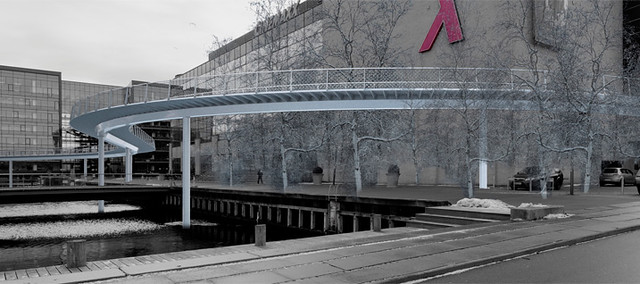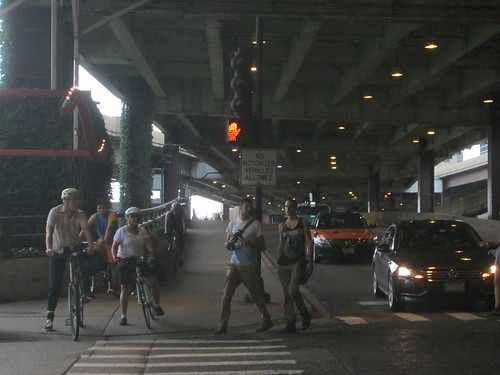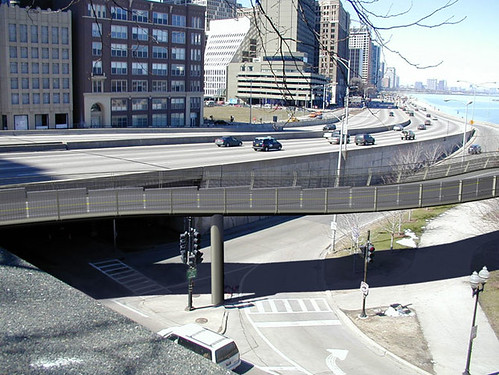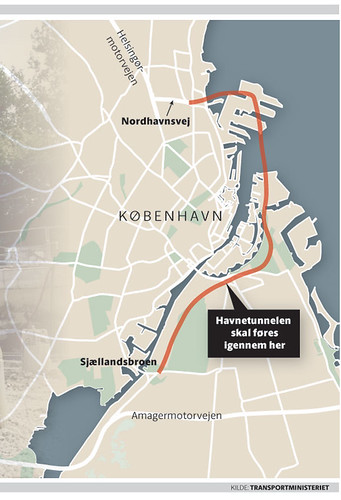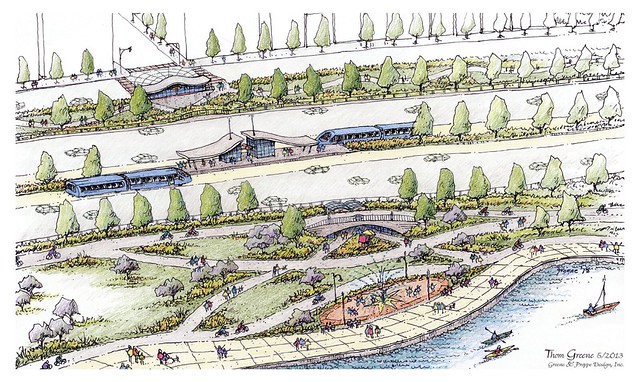[This is the second post of a two-part series by guest contributor Kristen Maddox. Part I compared the modal hierarchy, bike infrastructure and bike culture in Chicago and Copenhagen. Kristen recently spent a year in Denmark as a Fulbright fellow and worked with Copenhagenize Design Company. Now back in the US, she is actively looking for work in bicycle planning and advocacy.]
Despite the differences between Copenhagen’s and Chicago’s infrastructure, the two cities can learn from each other. Part II analyzes each city’s most out-of-the-box plans for motorized traffic and bicycles. We’ll compare Copenhagen’s Bicycle Snake with Chicago's Navy Pier Flyover, and contrast the Danish Capital’s proposed Harbor Tunnel with the Windy City's proposed North Lake Shore Drive redesign.
Bikeways in the sky
For all their differences, the Bicycle Snake (“Cykelslange”) and the Navy Pier Flyover have several things in common. The Snake will connect an existing bicycle and pedestrian bridge over the harbor with a higher portion of road leading from the Vesterbro neighborhood. The Bicycle Office and Copenhagenize Design Company have lauded the project’s ability to make bicycle transport even more streamlined.
Instead of having to dismount and carry their bikes down a curving flight of stairs, cyclists will now have the chance to zip down toward the waterfront on an elevated cycle track from a height of about 32 feet. By improving the connections on either end of an already popular bike and pedestrian bridge, the city expects to double the number of bridge users.
Similar to Copenhagen’s bicycle bridge, Chicago's Lakefront Trail is a valuable transportation and recreation facility, which the nonprofit Project for Public Spaces officially recognized as a “Great Public Space.” The Navy Pier Flyover will alleviate the current congestion problems on the trail where it travels under Lake Shore Drive near the pier.
A sign next to the Bicycle Snake construction site provides info about the project’s purpose and timeline. Placing informational signs next to the sites of future Chicago projects, such as the flyover, and existing routes, such the Dearborn protected bike lanes, could be a simple way to not only create more transparency and accountability for the projects but also spotlight locations where the city is paying attention to cyclists’ needs in new ways.
Chicago should also look into improving the technology associated with its new bicycle infrastructure projects. For example, the bike-specific traffic signals on Dearborn are great, but they can be improved. CDOT could possibly set up a Danish-style “green wave” of bike-friendly signal timing along Dearborn and Milwaukee.
The green wave originated in the Danish city of Odense and also used in Copenhagen. On routes where a green wave is established, cyclists traveling 12 mph, a moderate bike commuting speed, can enjoy an uninterrupted series of green lights. The new bike-specific traffic signals in Chicago could be also be synchronized to decrease bike commuting times, attracting more cyclists to these bikeways.
Major road projecta -- a tunnel and an 8-lane highway
The extent to which non-motorized transportation is prioritized can best be judged by the outcomes of new construction projects. The very words “Harbor Tunnel” can incite panic in Copenhagen. In a city that puts walking, biking and transit use first, it’s strange that this car-centric proposal was even considered. After lots of back and forth among politicians regarding whether or not the tunnel would be built, the plan is currently shelved.
The plan would have created a cars-only tunnel from the north to the south of Copenhagen, running underneath the Inner City. The $4.6 billion proposal had plenty of opposition. The Council for Sustainable Transport (“Rådet for Bæredygtig Trafik”) wrote a press release questioning the tunnel’s effectiveness for reducing car traffic. The project obviously would not result in improvements to transit or bicycle infrastructure. "It is therefore wrong when tunnel proponents postulate that with a port tunnel, cars are underground and therefore out of the way," the release reads. The group argued that the tunnel would only increase car use and discourage sustainable transportation.
The misguided tunnel proposal has had one positive outcome. It has refocused the attention of the public and the government toward active transportation needs. Due to the controversy, some forecast huge gains in the next election for the left-leaning "Red-Green Alliance" political party, the faction that was most vocal against the tunnel plan.
The Harbor Tunnel was an ill-conceived attempt to lower Copenhagen’s car congestion that thankfully has not come to fruition. Chicago’s "Redefine the Drive" project is a plan to rebuild and re-imagine one of the city’s most iconic thoroughfares: Lake Shore Drive. Unlike the Copenhagen proposal, the project will include a Project Study Group of five entities: The Illinois Department of Transportation, the Federal Highway Administration, CDOT, and the CTA.
The “Our Lakefront” proposal, presented by a coalition of 15 planning and advocacy groups, calls for more attention to be paid to the needs of pedestrians, bicyclists and transit users during the LSD redesign. If these constituencies are ignored, the resulting superhighway will encourage increased car usage and create potentially dangerous conditions for active transportation users. That would undermine the city of Chicago’s stated goal to create complete streets.
Hopefully the ideas put forward in “Our Lakefront” will prevail and the result will be a safer, more efficient, and more people-friendly Lake Shore Drive. That would be a step toward creating a Chicago that looks more like Copenhagen, and less like Houston.
